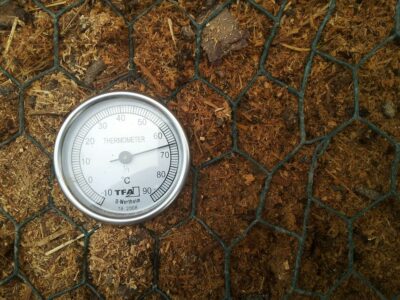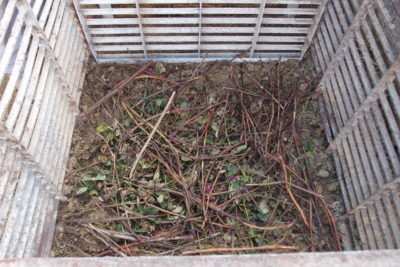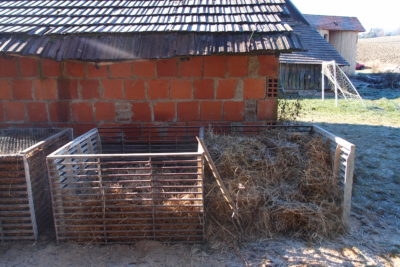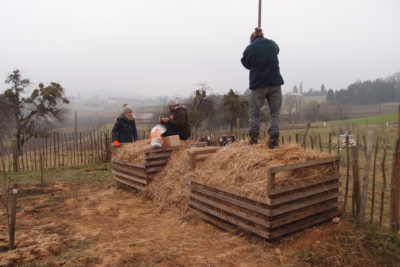Guidance: The Humanure Handbook by Joseph Jenkins, Biodynamic composting methods.
Ingredients: Manure and urine (pigeon, sheep, human), food scraps, plant material, hay, thin woody sticks, lime, occasionally animal carcass and other organic material.
Structures: Four of the compost bins were made of wood, the other three made by upcycling metal cattle barriers left from the previous farm owners.
Ideal compost environment:
Our composts followed specific layering of ingredients to hold oxygen, moisture, and a balanced nutrient environment for the billions of microorganisms destined to call the compost home. When using manure, the ideal compost environment is one that reaches high enough temperatures to ensure no pathogens, harmful bacteria or unwanted seeds can emerge from the final compost humus. This is done when the thermophilic activity is enough that, in a sense, natural pasteurization of the compost occurs. Thermophilic microorganisms (thermophiles) thrive at temperatures above 45°C. Here is Joseph Jenkins on the gift of these amazing ancient creatures:
“Just as extrao rdinary is the concept that thermophiles, despite their need for a hot environment, are found everywhere. They’re lingering in your garbage and in your stool… Researchers insist that thermophiles do not grow at ambient or room temperatures. Yet, like a miracle, when we collect our organic refuse into a tidy pile, the thermophiles seem to be sparked out of their dormant slumber to work furiously toward creating the primordial heat they so desire. And they succeed − if we help them by creating compost piles. They reward us for our help by converting our garbage and other organic discards into life-sustaining earth.” (The Humanure Handbook: A guide to composting human manure, page 40)
rdinary is the concept that thermophiles, despite their need for a hot environment, are found everywhere. They’re lingering in your garbage and in your stool… Researchers insist that thermophiles do not grow at ambient or room temperatures. Yet, like a miracle, when we collect our organic refuse into a tidy pile, the thermophiles seem to be sparked out of their dormant slumber to work furiously toward creating the primordial heat they so desire. And they succeed − if we help them by creating compost piles. They reward us for our help by converting our garbage and other organic discards into life-sustaining earth.” (The Humanure Handbook: A guide to composting human manure, page 40)
Compost design:

Dig a concave floor for the bins to ensure that no liquids will flow out of the compost, and to establish the connection between the Earth and the compost. Layer some woody sticks in the concave floor to allow aeration from the bottom of the compost. In our composts, we do not build more than 50cm of organic material without adding a layer of sticks to help lock oxygen into the compost.
Establish a thick layer of hay as absorbent organic material at the bottom of the compost to act as a “biological sponge”, absorbing what may otherwise leach from the compost. Our biological sponges were approximately 50cm high. Overtime, it will compact and decompose. Any other coarse organic material high in carbon can supplement hay, such as straw, leaves, shredded paper, etc. Grass clippings, weeds, and other plant clippings also work. Since our composts include manure – and get to high temperatures – we are not overly worried about seeds from the hay or weeds sprouting from our finished compost.

Directly onto the biological sponge layer kitchen scraps/green cuttings, manure, a little bit of soil, lime, and then a hay cover. The layering follows the guidance and advice of biodynamic composting. For example, lime is added to the compost to store information from the cosmos held in the rock (limestone) – it is our cosmic powder! The hay on top of the these layers acts as a cover material and biofilter to keep odors inside the compost. Repeat this layering until the compost is full. Hay is also used around the sides and on top of the final compost to insulate it, keeping heat and odors from seeping out.
With a compost that gets to high temperatures, virtually any decomposable organic material is fit to go into the compost. For example, as we keep sheep, any sheep carcass that we have is added to the compost rather than being buried – otherwise Malou, the farm dog, enjoys digging up a sheep hoof or skull. Composting is an easy, economic and environmentally sound way of dealing with animal mortalities. It can also benefit the compost. When we added the unused remains of one slaughtered sheep (the head and digestive system) the temperature of that compost jumped from 25°C to 41°C to 62°C in consecutive days. That compost remained above 60°C for three weeks.
Biodynamic inspiration: Connect the astral and the terrestrial for thriving soil, thriving plants, and thriving humans!
We received guidance from biodynamic composter, gardener, and cosmic connector, Bernard. After instructing us on the layer technique for the compost, Bernard came for a visit to treat the composts with his composting preparations. Five mixtures were added. Yarrow has an amazing capacity to regenerate the earth. Chamomile encourages the efficient and healthy natural cycle of growth, decomposition, and new growth. Nettle is added to detoxify and adapt the soil to the different plants grown. Oak bark helps the soil by encouraging balance, helping to cycle nutrients, and allowing plants to grow steadily and healthy. Dandelion offers garden soil the ability to provide crops with the liver-like power to filter exactly what they require from the soil. Finally, Bernard added a sixth ingredient to our composts, and he chose to keep that one a secret!
Each of these mixtures has specific preparation and storage procedures. For our biodynamic advice, when Bernard is not around, we reference the book Biodynamic Gardening: Grow healthy plants and amazing produce with the help of the Moon and Nature’s cycles.
The results:
We won’t know how life-giving and dynamic our compost is until the next growing season. So to know the results, you will have to continue to follow us here on the Obenaus website or on facebook… or much better, come for a visit! What we can comment on is that every single compost, with one exception, reached over 50°C for two days or longer. The one exception is the first compost we built, using the oldest ingredients and not following any layering technique.

Final thoughts:
There is no right way to compost – our composting method is just how we chose to experiment. Nor are the seven composts uniform -we adjusted and made changes throughout the process. Variety is not at all a bad thing. Rather what is important is that we all play our role in returning nutrients to the soil, supporting nutrient cycles that we observe throughout nature. We cannot continuously draw out nutrients without putting anything back. And so there is no better time than now for all of us to invest in the soil. Get composting folks!